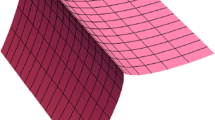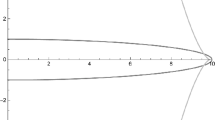Abstract
We propose a way to study the caustics of surfaces in non-flat Riemannian 4-space form from the viewpoint of singularity theory in this paper. As an application of the theory of Lagrangian singularity, we study the contact of surfaces with the families of hyperspheres, which is measured by the singularities of functions defined on the surfaces.
Similar content being viewed by others
Data Availability
The data obtained in this paper can be shared openly.
References
Arnol’d, V.I., Gusein-Zade, S.M., Varchenko, A.N.: Singularities of differentiable maps, vol. I Birkhäuser, (1986)
Banchoff, T., Gaffney, T., McCrory, C.: Cusps of Gauss mappings, Research Notes in Mathematics, vol. 55 Pitman, (1982)
Bleeker, D., Wilson, L.: Stability of Gauss maps. Illinois J. Math. 22, 279–289 (1978)
Bruce, J.W., Giblin, P.J.: Curves and Singularities, 2nd edn. Cambridge University Press (1992)
Bruce, J.W.: Generic geometry, transversality and projections. J. London Math. Soc. 49(2), 183–194 (1994)
Cecil, T.E., Ryan, P.J.: Focal sets of submanifolds. Pacific J. Math. 78(1), 27–39 (1978)
Cheshkova, M.A.: Evolute surfaces in \(E^4\). Math. Notes 70(6), 870–872 (2001)
Fuchs, D.: Evolutes and involutes of spatial curves. Amer. Math. Monthly 120, 217–231 (2013)
Goryunov, V.V.: Projections of generic surfaces with boundaries. Adv. Soviet Math. 1, 157–200 (1990)
Golubitsky, M., Guillemin, V.: Contact equivalence for Lagrangian manifold. Adv. Math. 15, 375–387 (1975)
Goryunov, V.V., Gallagher, K.: On planar caustics. J. Knot Theory Ramif. 25(12), 1642004 (2016)
Gounai, H., Umehara, M.: Caustics of convex curves. J. Knot Theory Ramif. 23(10), 1450050 (2014)
Hayashi, R., Izumiya, S., Sato, T.: Focal surfaces and evolutes of curves in hyperbolic space. Commun. Korean Math. Soc. 32(1), 147–163 (2017)
Izumiya, S., Pei, D.H., Sano, T.: Singularities of hyperbolic Gauss maps. Proc. Lond. Math. Soc. 86, 485–512 (2003)
Izumiya, S., Pei, D.H., Sano, T., Torii, E.: Evolutes of hyperbolic plane curves. Acta Math. Sin. (Engl. Ser.) 20(3), 543–550 (2004)
Izumiya, S., Pei, D.H., Takahashi, M.: Singularities of evolutes of hypersurfaces in hyperbolic space. Proc. Edinb. Math. Soc. 47(1), 131–153 (2004)
Izumiya, S., Takahashi, M.: On caustics of submanifolds and canal hypersurfaces in Euclidean space. Topology Appl. 159(2), 501–508 (2012)
Izumiya, S.: Caustics and Maxwell sets of world sheets in anti-de Sitter space. Adv. Theor. Math. Phys. 22(3), 759–802 (2018)
Josse, A., Pène, F.: On caustics by reflection of algebraic surfaces. Adv. Geom. 16(4), 437–464 (2016)
Looijenga, E.J.N.: Structural stability of smooth families of \(C^\infty \)-functions, PhD thesis, University of Amsterdam (1974)
Loutsenko, I.: On the role of caustics in solar gravitational lens imaging. PTEP. Prog. Theor. Exp. Phys. 12, 123A02 (2018)
Martinet, J.: Singularities of smooth functions and maps, London Mathematical Society Lecture Notes Series, vol. 58, Cambridge University Press, (1982)
Mochida, D.K.H., Romero Fuster, M.C., Ruas, M.A.S.: The geometry of surfaces in \(4\)-space from a contact viewpoint. Geom. Dedicata. 54(3), 323–332 (1995)
Mochida, D.K.H., Romero-Fuster, M.C., Ruas, M.A.S.: Singularities and duality in the flat geometry of submanifolds of Euclidean spaces. Beitrage Algebra Geom. 42(1), 137–148 (2001)
Montaldi, J.A.: On contact between submanifolds. Michigan Math. J. 33, 195–199 (1986)
Montaldi, J.A.: Surfaces in \(3\)-space and their contact with circles. J. Diff. Geom. 23(2), 109–126 (1986)
Montaldi, J.A.: On generic composites of maps. Bull. Lond. Math. Soc. 23, 81–85 (1991)
Pasmatsiou, K.: Caustic formation upon shift symmetry breaking. Phys. Rev. D 97(3), 036008 (2018)
Porteous, I.R.: Geometric Differentiation for the Intelligence of Curves and Surfaces, 2nd edn. Cambridge University Press, Cambridge (2001)
Tari, F.: Caustics of surfaces in the Minkowski 3-space. Q. J. Math. 63(1), 189–209 (2012)
Wassermann, G.: Stability of caustics. Math. Ann. 216, 43–50 (1975)
Acknowledgements
The authors would like to express extremely gratitude to the anonymous referees for insightful comments on and valuable improvements to our original manuscript. The first author would also like to thank Professor Osamu Saeki for his kindness and hospitality during his visiting in Japan. Also, the authors would like to pay tribute to Professor Osamu Saeki for making an effort to strengthen friendships between mathematicians in China and Japan. The first author was partially supported by National Nature Science Foundation of China (Grant No. 12271086).
Author information
Authors and Affiliations
Corresponding author
Additional information
Publisher's Note
Springer Nature remains neutral with regard to jurisdictional claims in published maps and institutional affiliations.
\(\dag \) The work is partially supported by National Nature Science Foundation of China (Grant No. 12271086).
Generating family
Generating family
In this section we briefly review the theories of Lagrangian singularities and generating family due to Arnol’d [1] (please also refer to [16]). Suppose that \(\pi : T^*\mathbb R^r\rightarrow {\mathbb {R}}^r\) is the cotangent bundle over \({\mathbb {R}}^r\). Then the canonical symplectic structure on \(T^*{\mathbb {R}}^r\) is given by the canonical 2-form \(\omega =\sum _{i=1}^rdp_i\wedge du_i\), where \((u, p)=(u_1,\cdots , u_r, p_1.\cdots , p_r)\) is the canonical local coordinate on \(T^*{\mathbb {R}}^r\). Let \(i: L\rightarrow T^*{\mathbb {R}}^r\) be an immersion. We call i the Lagrangian immersion if \(\textrm{dim}L=r\) and \(i^*\omega =0\). In this case the critical value of \(\pi \circ i\) is called the caustic of i and denoted by \(C_L\). Let \(F:({\mathbb {R}}^n\times {\mathbb {R}}^r, (0,0))\rightarrow ({\mathbb {R}}, 0)\) be a family of function germs. We denote
and call it the catastrophe set of F. We also call
the bifurcation set of F. Let \(\pi _r:({\mathbb {R}}^n\times {\mathbb {R}}^r, (0,0))\rightarrow ({\mathbb {R}}^r, 0)\) be the canonical projection, then we can show that the bifurcation set of F is the critical value set of \(\pi _r|_{C(F)}\).
We call F is a Morse family if the map germ
is non-singular, where \((x, u)=(x_1, \cdots , x_n, u_1, \cdots , u_r)\in ({\mathbb {R}}^n\times {\mathbb {R}}^r, (0,0))\). In this case we have a smooth submanifold germ \(C(F)\subset ({\mathbb {R}}^n\times {\mathbb {R}}^r, (0,0))\), and then we can define a map germ \(L(F): (C(F), 0)\rightarrow T^*{\mathbb {R}}^r\) by
We can easily show that L(F) is a Lagrangian immersion. Then we have the following well known theorem [1].
Theorem A.1
All Lagrangian submanifold germs in \(T^*{\mathbb {R}}^r\) are constructed by the above method. F is called a generating family of L(F).
Rights and permissions
Springer Nature or its licensor (e.g. a society or other partner) holds exclusive rights to this article under a publishing agreement with the author(s) or other rightsholder(s); author self-archiving of the accepted manuscript version of this article is solely governed by the terms of such publishing agreement and applicable law.
About this article
Cite this article
Chen, L., Jiang, Y. & Yu, H. Singularities of caustics of surfaces in non-flat Riemannian 4-space form\(^\dag \). Res Math Sci 11, 25 (2024). https://doi.org/10.1007/s40687-024-00437-y
Received:
Accepted:
Published:
DOI: https://doi.org/10.1007/s40687-024-00437-y




